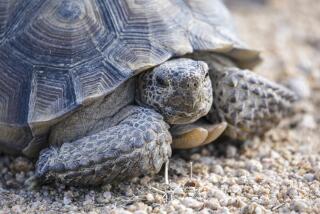Giant tortoises make excellent lawn mowers
- Share via
Forget the John Deere tractor: giant island tortoises make the best lawn mowers, according to a new study.
In an effort to control the alien plants that had dominated a small island in the Indian Ocean for decades, scientists introduced two types of land tortoises.
Round Island, a 529-acre island off the coast of Mauritius, has a long history of onslaught by invasive species. The island was overrun in the 1800s by rabbits and goats brought in by humans. The critters stripped the island bare, threatening a host of native reptiles and a substantial seabird colony. In the 1970s authorities removed the rabbits and goats, but the results were mixed. Without the animals’ constant grazing, weeds sprang up, overrunning the island’s native plants.
Fast-forward to 2006, when the local Mauritian Wildlife Federation and collaborating scientists had a wacky idea that they thought just might work — introducing two tortoise species, the Aldabran giant tortoise and the Madagascan radiated tortoise, from neighboring Mauritius to control the weeds.
It wasn’t entirely far-fetched. Two extinct species of giant tortoise, Cylindraspis inepta and C. triserrata, roamed Round Island before humans arrived and did what we do. (The last record of a live native tortoise on the island was in 1844.) But the idea raised some concern because it entailed introducing alien species (tortoises) to control other alien species (weeds). Many in the conservation community believe strongly that alien equals bad (and its converse: that native equals good).
“When you say you’re going to introduce an exotic [alien] species, the first thing you think is it’s going to become invasive,” said Christine Griffiths, the lead author of the study, which was published online last month in the journal Conservation Biology.
“Mauritius has a wonderful track record of having introduced exotics to disastrous consequences,” she said.
But Griffiths didn’t worry about a rogue colony of giant tortoises rising up. For one, tortoises are extremely long-lived, not exactly fitting the typical invasive species profile. And more importantly, the alien tortoises would perform a very similar ecological role to the native extinct tortoises — they have voracious appetites, and they’re not picky. Griffiths and her team figured that since the alien plants grow faster than the native plants (and are simply more abundant), the tortoises would spend most of their time weeding, rather than chowing down on native fare.
To test the idea, they constructed enclosed study plots of vegetation, recording the type and abundance of all plants in the plots. Next came the fun part: Captive-bred tortoises from Mauritius were airlifted via helicopter in “underslings” and dropped on their new home of Round Island.
Griffiths’ team released two tortoises in each enclosed study plot and established control plots without any tortoises. They then monitored the plants’ response over the next 11 months. Since there were few native plants in the plots, they were excluded from the analysis.
Over the course of the study period, the tortoises did the trick, vastly reducing the height, abundance, and biomass of the alien plants, which thrived in the control plots. The Aldabran tortoises were especially effective, reducing plant biomass 136 times more than in the control plots.
“It was a moment of wow — why hadn’t we done this years ago?” said Griffiths.
To further test the tortoises, the team let them freely range over the island and then collected their feces. Examining the seeds and other plant parts left in the fecal samples, they found that 81% of the Aldabran tortoise diet consisted of alien plants, while the Madagascan diet was 93% alien. Almost three quarters of the native plants available in the range remained untouched.
So what does it all mean? Should you trade in your lawn mower for a tortoise?
Griffiths’ team conducted a final economic analysis, comparing the cost of using tortoises to weed the island versus the cost of wardens manually performing the task. Although it would cost more to use tortoises for the first six years, they calculated, after that it would become more expensive to rely on people. The cumulative cost of salary, food, transportation and equipment for human weeders would surpass the initial cost of introducing tortoises — and maintaining tortoises over time is practically cost-free.
The jury seemed to have reached a verdict, the researchers said: Bring in the tortoises.
“You can sit back and have a cocktail while they do the work for you,” Griffiths said.
You can read a summary of the study here.
Return to Science Now.
Follow on Twitter: @BradBalukjian






